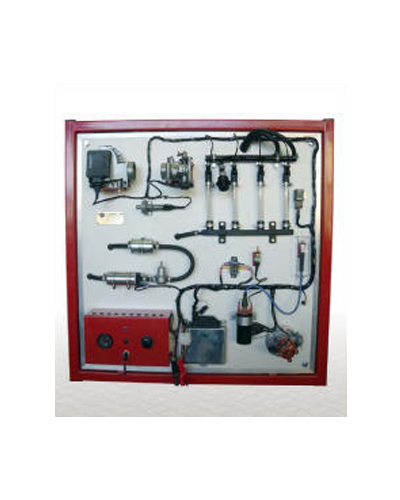- +91-9971077233, +91-9821041467
- labequipments.in@gmail.com
- ENG

The Four-Cylinder Engine trainer should consist of a complete, fully operational Multi Point EFI system. Original components should be utilized and clearly laid out on a display board that is mounted on an integrated floor stand, made from powder coated electro galvanized steel, mounted onto wheels for mobility. A color coded schematic chart, under a lexon polycarbonate protective screen, of the EFI system and circuit’s, should also be mounted onto the trainer for reference.
The engine sensors have a signal generator to simulate various engine conditions and a corresponding electrical meter that continuously monitors the signal. The effect of altering the sensor condition should be immediately apparent on the meters. The Electrical wiring diagram is provided in a special design panel to incorporate Input / Output connections from sensors and ECU. ECU should be open source and programmable and have the ability to connect to a PC, for programming and displaying system data.
Specifications:
1. The following components should be included in Multi point EFI System Trainer:
A. Prime Components and Systems
Electronic Control Unit (ECU)
Test Point Panel for ECU Input/Outputs
Fuel Tank Reservoir
Electric Fuel Pump with pressure gauge
Fuel Filter
Fuel Distributor Rail with pressure gauge
Fuel Injectors
Fuel Pressure Regulator
Graduated Fuel Volume Meter for each Injector
Complete Ignition System (detailed below)
Variable speed drive for ignition with Tachometer
Silk-screened engine Diagram showing layout of components
Throttle position sensor
Mass Air Flow Sensor
Complete system sensors (detailed below)
Sensor controls with meters (detailed below)
Electrical relays and control devices
B. Sensors and Actuators
Mass Air Flow Sensor or map sensor
Intake Air Temperature sensor
Throttle Position sensor
Crankshaft Position and Engine Speed sensor
Engine Temperature (coolant) sensor
Lambda sensor
C. Ignition System
Ignition Coil
Ignition Distributor or Distributor less ignition
Infinitely Variable Drive System for distributor
Spark Plugs
Set of High Tension Leads
D. System Controls and Devices
Key Ignition switch with pilot lights
System Relays
Electronic Control Unit (ECU)
Engine Speed Control
Air Flow Control
Throttle position Control
Intake Air Temperature Control
Engine Temperature (coolant) Control
Lambda (Oxygen) Control
Battery Voltage Control
E. Meters and Gauges
Mass Air Flow meter
Throttle Position meter
Intake Air Temperature meter
Engine (coolant) Temperature meter
Engine Speed Tachometer (RPM)
Lambda (Oxygen) meter
Battery Voltage meter
Fuel Pump pressure gauge
Fuel Rail pressure gauge
F. 12 VDC Regulated Power Supply, 30 Amps
2. Accessories: A set of 4mm terminals.
3. Included Accessories:
A. Electronic Fault Insertion System:
a. Multiple electronic fault insertion system: This system should allow for 10 faults to be inserted at any one time. Faults can be inserted individually or in groups.
b. Electrical Circuit Diagram Panel with Test Points: Features electrical circuit diagram panel that incorporates electrical test points that allow the student to take measurements during the troubleshooting exercises.
c. Electronic Fault Insertion System with LED Display: This should be incorporated into the electrical Circuit Diagram panel. The system should be able to activate the fault via pushbuttons that in turn operate electrical relays that cause the fault to occur. When the fault is electronically activated a corresponding LED will illuminate showing the fault is active.
d. Student Testing Mode: The LED fault indication display can be deactivated, so that the faults can be active but the display is switched off.
e. Electronic Fault Reset Button: The LED control should have a fault-reset button that will clear and reset the system back to normal.
The trainer should come complete with a training course on the EFI fuel injection system operation and servicing including student job sheets and a technician manual.